What Caused Industrial Psychologists to Begin Working With the Military?
78 What Is Industrial and Organizational Psychology?
[latexpage]
Learning Objectives
Past the end of this section, you lot volition be able to:
- Empathise the scope of study in the field of industrial and organizational psychology
- Describe the history of industrial and organizational psychology
In 2012, people who worked in the United States spent an average of 56.4 hours per week working (Bureau of Labor Statistics—U.Southward. Department of Labor, 2013). Sleeping was the but other action they spent more time on with an average of 61.2 hours per week. The workday is a significant portion of workers' time and energy. Information technology impacts their lives and their family unit'southward lives in positive and negative physical and psychological ways. Industrial and organizational (I-O) psychology is a branch of psychology that studies how human behavior and psychology affect piece of work and how they are affected by work.
Industrial and organizational psychologists work in four main contexts: academia, government, consulting firms, and concern. Most I-O psychologists take a primary's or doctorate degree. The field of I-O psychology tin exist divided into three wide areas ([link] and [link]): industrial, organizational, and human factors. Industrial psychology is concerned with describing job requirements and assessing individuals for their ability to meet those requirements. In addition, one time employees are hired, industrial psychology studies and develops ways to railroad train, evaluate, and respond to those evaluations. As a upshot of its business organization for candidate characteristics, industrial psychology must also consider issues of legality regarding discrimination in hiring. Organizational psychology is a discipline interested in how the relationships among employees affect those employees and the functioning of a business. This includes studying worker satisfaction, motivation, and commitment. This field also studies management, leadership, and organizational civilization, as well equally how an organization's structures, direction and leadership styles, social norms, and role expectations affect private behavior. Equally a effect of its involvement in worker wellbeing and relationships, organizational psychology also considers the subjects of harassment, including sexual harassment, and workplace violence. Human factors psychology is the study of how workers interact with the tools of work and how to pattern those tools to optimize workers' productivity, safe, and health. These studies can involve interactions as straightforward as the fit of a desk-bound, chair, and computer to a human having to sit on the chair at the desk using the computer for several hours each day. They tin also include the exam of how humans interact with complex displays and their ability to interpret them accurately and quickly. In Europe, this field is referred to every bit ergonomics.
(a) Industrial psychology focuses on hiring and maintaining employees. (b) Organizational psychology is interested in employee relationships and organizational civilization. (credit a: modification of work by Cory Zanker; credit b: modification of work by Vitor Lima)
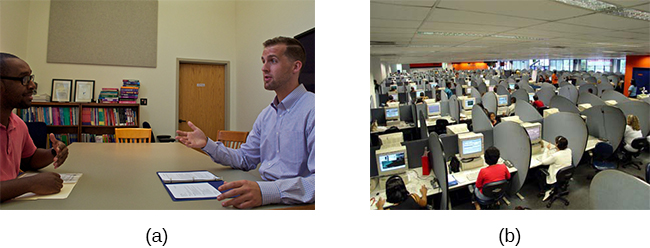
Human being factors psychology is the written report of interactions between humans, tools, and work systems.
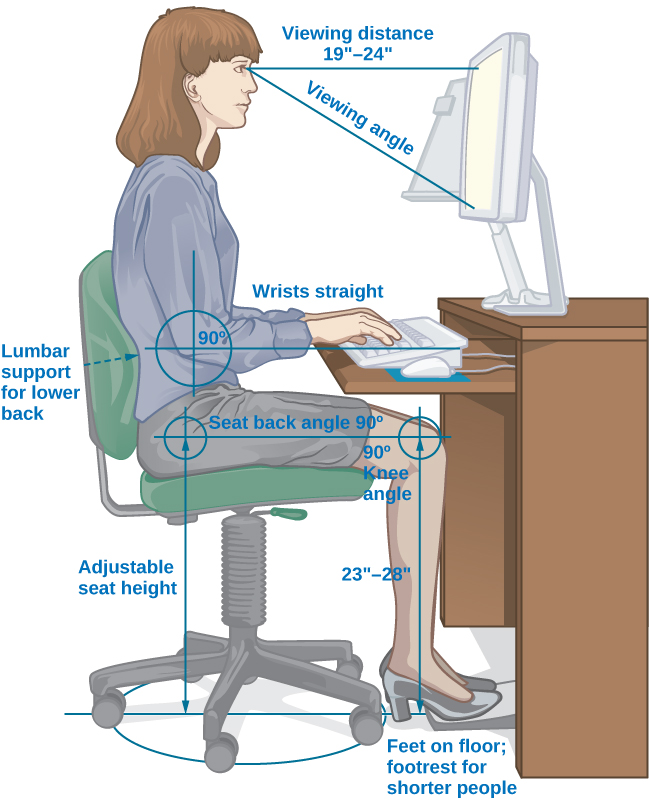
THE HISTORICAL DEVELOPMENT OF INDUSTRIAL AND ORGANIZATIONAL PSYCHOLOGY
Industrial and organizational psychology had its origins in the early on 20th century. Several influential early psychologists studied issues that today would be categorized as industrial psychology: James Cattell (1860–1944) at Columbia, Hugo Münsterberg (1863–1916) at Harvard, Walter Dill Scott (1869–1955) at Northwestern, Robert Yerkes (1876–1956) and Walter Bingham (1880–1952) at Dartmouth, and Lillian Gilbreth (1878–1972) at Purdue. Cattell, Münsterberg, and Scott had been students of Wilhelm Wundt, the father of experimental psychology. Some of these researchers had been involved in work in the area of industrial psychology before World State of war I. Cattell'due south contribution to industrial psychology is largely reflected in his founding of a psychological consulting company, which is still operating today called the Psychological Corporation, and in the accomplishments of students at Columbia in the area of industrial psychology. In 1913, Münsterberg published Psychology and Industrial Efficiency, which covered topics such every bit employee pick, employee training, and constructive advertising.
Scott was one of the get-go psychologists to use psychology to advertising, management, and personnel pick. In 1903, Scott published 2 books: The Theory of Advertising and Psychology of Advert. They are the first books to describe the use of psychology in the business world. Past 1911 he published ii more books, Influencing Men in Business and Increasing Man Efficiency in Business. In 1916 a newly formed division in the Carnegie Institute of Technology hired Scott to conduct applied research on employee selection (Katzell & Austin, 1992).
The focus of all this research was in what nosotros now know as industrial psychology; it was simply later in the century that the field of organizational psychology developed as an experimental science (Katzell & Austin, 1992). In add-on to their bookish positions, these researchers besides worked directly for businesses as consultants.
The involvement of the United states of america in World War I in April 1917 catalyzed the participation in the military effort of psychologists working in this expanse. At that fourth dimension Yerkes was the president of the 25-yr-onetime American Psychological Association (APA). The APA is a professional clan in the United States for clinical and inquiry psychologists. Today the APA performs a number of functions including belongings conferences, accrediting university degree programs, and publishing scientific journals. Yerkes organized a group under the Surgeon General's Part (SGO) that developed methods for screening and selecting enlisted men. They developed the Regular army Alpha exam to measure out mental abilities. The Army Beta examination was a non-verbal form of the exam that was administered to illiterate and not-English-speaking draftees. Scott and Bingham organized a group nether the Adjutant Full general'due south Office (AGO) with the goal to develop selection methods for officers. They created a catalogue of occupational needs for the Regular army, essentially a job-description system and a system of performance ratings and occupational skill tests for officers (Katzell & Austin, 1992).
Later the war, work on personnel selection continued. For example, Millicent Pond, who received a PhD from Yale University, worked at several businesses and was director of employment test research at Scoville Manufacturing Company. She researched the option of factory workers, comparing the results of pre-employment tests with various indicators of job performance. These studies were published in a series of enquiry articles in the Periodical of Personnel Inquiry in the belatedly 1920s (Vinchur & Koppes, 2014).
From 1929 to 1932 Elton Mayo (1880–1949) and his colleagues began a series of studies at a plant almost Chicago, Western Electric'south Hawthorne Works ([link]). This long-term project took industrial psychology beyond just employee selection and placement to a written report of more than complex bug of interpersonal relations, motivation, and organizational dynamics. These studies mark the origin of organizational psychology. They began equally research into the effects of the physical work environment (e.m., level of lighting in a factory), simply the researchers found that the psychological and social factors in the factory were of more interest than the physical factors. These studies also examined how man interaction factors, such as supervisorial style, enhanced or decreased productivity.
Hawthorne Works provided the setting for several early on I-O studies.
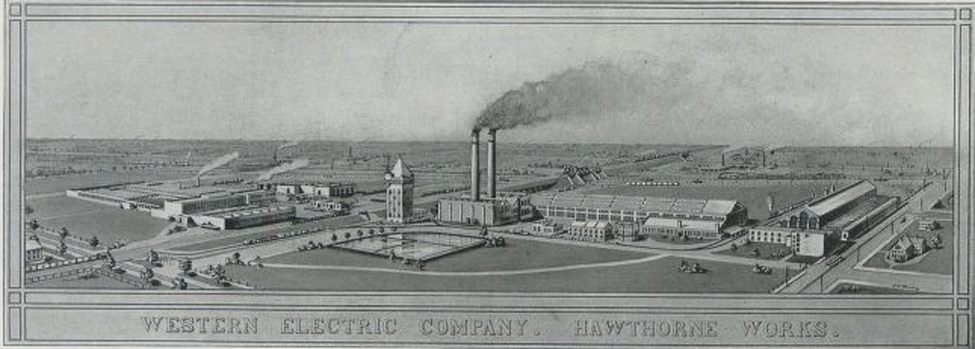
Analysis of the findings by later researchers led to the term the Hawthorne effect, which describes the increase in performance of individuals who are noticed, watched, and paid attending to past researchers or supervisors [link]). What the original researchers found was that whatever alter in a variable, such as lighting levels, led to an improvement in productivity; this was true even when the change was negative, such every bit a return to poor lighting. The issue faded when the attention faded (Roethlisberg & Dickson, 1939). The Hawthorne-consequence concept endures today equally an important experimental consideration in many fields and a gene that has to be controlled for in an experiment. In other words, an experimental treatment of some kind may produce an event but considering it involves greater attention of the researchers on the participants (McCarney et al., 2007).
Researchers discovered that employees performed better when researchers or supervisors observed and interacted with them, a dynamic termed the Hawthorne issue.


Lookout this video to hear first-hand accounts of the original Hawthorne studies from those who participated in the inquiry.
In the 1930s, researchers began to study employees' feelings most their jobs. Kurt Lewin also conducted research on the effects of diverse leadership styles, team structure, and team dynamics (Katzell & Austin, 1992). Lewin is considered the founder of social psychology and much of his piece of work and that of his students produced results that had of import influences in organizational psychology. Lewin and his students' inquiry included an important early study that used children to study the upshot of leadership fashion on aggression, group dynamics, and satisfaction (Lewin, Lippitt, & White, 1939). Lewin was also responsible for coining the term group dynamics, and he was involved in studies of group interactions, cooperation, competition, and advice that touch on organizational psychology.
Parallel to these studies in industrial and organizational psychology, the field of homo factors psychology was besides developing. Frederick Taylor was an engineer who saw that if 1 could redesign the workplace there would be an increase in both output for the visitor and wages for the workers. In 1911 he put frontward his theory in a book titled, The Principles of Scientific Direction ([link]). His volume examines management styles, personnel selection and training, equally well every bit the piece of work itself, using fourth dimension and motion studies.
(a) Frederick Taylor (1911) strived to engineer workplaces to increase productivity, based on the ideas he prepare forth in (b) his book, The Principles of Scientific Management. (c) Taylor designed this steam hammer at the Midvale Steel Company. (credit c: modification of work past "Kheel Center, Cornell University"/Flickr)
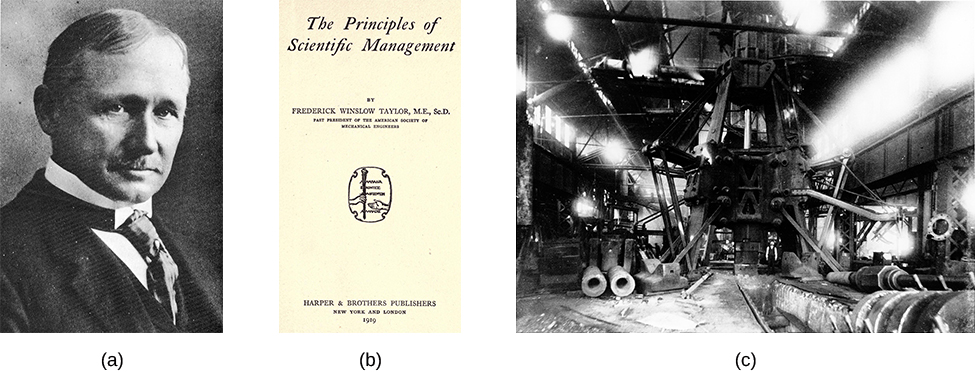
One of the examples of Taylor's theory in action involved workers treatment heavy iron ingots. Taylor showed that the workers could be more productive by taking work rests. This method of rest increased worker productivity from 12.5 to 47.0 tons moved per 24-hour interval with less reported fatigue equally well as increased wages for the workers who were paid by the ton. At the aforementioned time, the company's cost was reduced from 9.2 cents to three.9 cents per ton. Despite these increases in productivity, Taylor's theory received a great deal of criticism at the time because it was believed that it would exploit workers and reduce the number of workers needed. Also controversial was the underlying concept that simply a manager could determine the virtually efficient method of working, and that while at work, a worker was incapable of this. Taylor's theory was underpinned past the notion that a worker was fundamentally lazy and the goal of Taylor's scientific management approach was to maximize productivity without much business for worker well-being. His approach was criticized by unions and those sympathetic to workers (Van De Water, 1997).
Gilbreth was some other influential I-O psychologist who strove to find ways to increase productivity ([link]). Using time and motility studies, Gilbreth and her husband, Frank, worked to make workers more than efficient by reducing the number of motions required to perform a task. She not only applied these methods to manufacture just also to the habitation, function, shops, and other areas. She investigated employee fatigue and time management stress and found many employees were motivated by money and task satisfaction. In 1914, Gilbreth wrote the book championship, The Psychology of Management: The Office of the Heed in Determining, Teaching, and Installing Methods of To the lowest degree Waste, and she is known as the mother of modernistic direction. Some of Gilbreth'southward contributions are still in employ today: you lot can thank her for the idea to put shelves inside on refrigerator doors, and she also came up with the concept of using a foot pedal to operate the lid of trash can (Gilbreth, 1914, 1998; Koppes, 1997; Lancaster, 2004). Gilbreth was the first adult female to join the American Society of Mechanical Engineers in 1926, and in 1966 she was awarded the Hoover Medal of the American Society of Civil Engineers.
Taylor and Gilbreth's piece of work improved productivity, but these innovations also improved the fit between applied science and the human using information technology. The study of machine–human being fit is known every bit ergonomics or human being factors psychology.
(a) Lillian Gilbreth studied efficiency improvements that were applicative in the workplace, home, and other areas. She is credited with the idea of (b) putting shelves on the inside of refrigerator doors and (c) pes-pedal-operated garbage cans. (credit b: modification of work past "Goedeker'south"/Flickr; credit c: modification of work past Kerry Ceszyk)
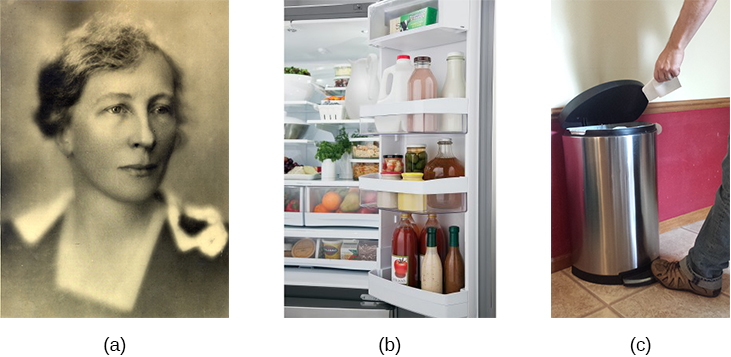
FROM WWII TO TODAY
World State of war II also drove the expansion of industrial psychology. Bingham was hired equally the chief psychologist for the War Department (now the Department of Defense force) and developed new systems for job choice, nomenclature, training, advert performance review, plus methods for team development, morale alter, and mental attitude modify (Katzell & Austin, 1992). Other countries, such as Canada and the United Kingdom, too saw growth in I-O psychology during Earth War II (McMillan, Stevens, & Kelloway, 2009). In the years after the state of war, both industrial psychology and organizational psychology became areas of significant research effort. Concerns about the fairness of employment tests arose, and the ethnic and gender biases in various tests were evaluated with mixed results. In addition, a great bargain of research went into studying task satisfaction and employee motivation (Katzell & Austin, 1992). Today, I-O psychology is a various and deep field of research and do, equally y'all will acquire about in the rest of this chapter. The Guild for Industrial and Organizational Psychology (SIOP), a division of the APA, lists eight,000 members (SIOP, 2014) and the Bureau of Labor Statistics—U.S. Department of Labor (2013) has projected this profession will take the greatest growth of all job classifications in the 20 years following 2012. On average, a person with a master's degree in industrial-organizational psychology will earn over $80,000 a year, while someone with a doctorate will earn over $110,000 a twelvemonth (Khanna, Medsker, & Ginter, 2012).
Summary
The field of I-O psychology had its birth in industrial psychology and the use of psychological concepts to aid in personnel selection. Even so, with research such every bit the Hawthorne report, it was found that productivity was affected more by man interaction and not physical factors; the field of industrial psychology expanded to include organizational psychology. Both WWI and WWII had a potent influence on the development of an expansion of industrial psychology in the U.s.a. and elsewhere: The tasks the psychologists were assigned led to development of tests and research in how the psychological concepts could assist industry and other areas. This movement aided in expanding industrial psychology to include organizational psychology.
Review Questions
Who was the first psychologist to apply psychology in advertising?
- Hugo Münsterberg
- Elton Mayo
- Walter Dill Scott
- Walter Bingham
C
Which examination designed for the Ground forces was used for recruits who were non fluent in English?
- Regular army Personality
- Regular army Alpha
- Army Beta
- Army Intelligence
C
Which expanse of I-O psychology measures job satisfaction?
- industrial psychology
- organizational psychology
- human factors psychology
- ad psychology
B
Which statement best describes the Hawthorne effect?
- Giving workers remainder periods seems like it should subtract productivity, simply it actually increases productivity.
- Social relations amid workers accept a greater upshot on productivity than physical environment.
- Changes in light levels improve working conditions and therefore increment productivity.
- The attention of researchers on subjects causes the issue the experimenter is looking for.
D
Disquisitional Thinking Questions
What societal and management attitudes might have caused organizational psychology to develop later on than industrial psychology?
Answers will vary. The student should insinuate to the fact that organizational psychology finds social relations of employees important and that historically workers were thought of more every bit private machines rather than a social group.
Many of the examples of I-O psychology are applications to businesses. Name four different non-business contexts that I-O psychology could impact?
Answers will vary. The student should identify organizations that are dedicated to accomplishing specific tasks, in the full general sense. Examples are hospitals, not-profit organizations, government agencies (including the military), police enforcement, universities, schools, and then on.
Personal Application Question
Which of the wide areas of I-O psychology interests you the most and why?
Glossary
- Hawthorne effect
- increment in operation of individuals who are noticed, watched, and paid attention to past researchers or supervisors
- human factors psychology
- branch of psychology that studies how workers interact with the tools of piece of work and how to design those tools to optimize workers' productivity, safety, and wellness
- industrial and organizational (I-O) psychology
- field in psychology that applies scientific principles to the written report of work and the workplace
- industrial psychology
- branch of psychology that studies job characteristics, bidder characteristics, and how to match them; as well studies employee training and performance appraisal
- organizational psychology
- branch of psychology that studies the interactions between people working in organizations and the effects of those interactions on productivity
Source: https://opentext.wsu.edu/psych105nusbaum/chapter/what-is-industrial-and-organizational-psychology/
0 Response to "What Caused Industrial Psychologists to Begin Working With the Military?"
Post a Comment